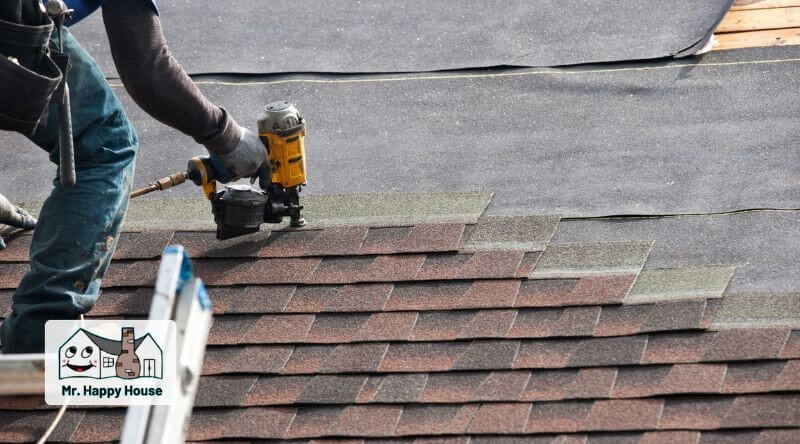
Best GAF Certified Roofers in The Woodlands, TX – Quality Roof Replacement, Gutters & Siding
Best GAF Certified Roofers in The Woodlands, TX – Quality Roof Replacement, Gutters & Siding Best GAF Certified Roofers in The Woodlands, TX – Quality

Owning a home is a significant investment, and one of the key elements in protecting that investment is homeowners insurance. While homeowners insurance provides a safety net for various unexpected events, one area where it can be particularly valuable is in covering the cost of roof replacement.
A damaged roof can lead to extensive and costly repairs, many times, repairing a roof with extensive damage will not fix the underlying issues and will necessitate a full replacement. It’s crucial to understand how to navigate the roof insurance claims process to ensure you receive the coverage you’re entitled to.
In this guide, we’ll walk you through the steps on how to get insurance to pay for roof replacement. It’s important to note that we are committed to discussing this process in a legal and ethical manner.
While some may be tempted to cut corners or take illegal shortcuts, the consequences of such actions far outweigh any potential benefits. We firmly believe that an honest and legitimate approach is not only the right way to go but also the most reliable way to secure the financial support you need for your roof replacement.
Homeowners insurance serves as a financial safety net for homeowners, providing protection against unexpected events that could lead to property damage or loss. Its primary purpose is to help homeowners recover financially from such situations. This includes coverage for various perils, including natural disasters, accidents, theft, and, relevant to this guide, roof damage.
Homeowners insurance typically covers roof damage caused by specific perils. These perils may include:
Storm Damage: Damage caused by severe storms, including high winds, hail, and lightning strikes, is often covered by homeowners insurance policies.
Fire: If your roof is damaged or destroyed by a fire, homeowners insurance should provide coverage to repair or replace it.
Vandalism: Malicious acts, such as vandalism, that result in roof damage are typically covered.
Falling Objects: If a tree, branch, or other object falls onto your roof and causes damage, homeowners insurance should cover the repair costs.
It’s important to review your insurance policy to understand the specific perils covered, as policies can vary. Moreover, the extent of coverage depends on your policy’s terms and limits.
It’s essential to emphasize that the process of getting insurance to pay for roof replacement must be conducted within the bounds of the law. Attempting to deceive or defraud an insurance company is illegal and can result in severe consequences, including policy cancellation and legal action. This guide is focused on the legitimate and ethical approach to making a claim, ensuring that you receive the coverage you deserve without engaging in fraudulent activities.
As we proceed, we will explore the steps and considerations involved in navigating the homeowners insurance process for roof replacement while adhering to the highest ethical standards. Understanding the coverage your policy offers and the legal framework surrounding insurance claims is the foundation upon which successful roof replacement claims are built.
Before you can begin the process of getting your insurance to pay for a roof replacement, you must first determine if your roof is genuinely damaged. Common causes of roof damage include:
Weather-Related Damage: Heavy storms, hail, strong winds, and extreme temperature fluctuations can all take a toll on your roof over time.
Aging: Roofs have a natural lifespan, and as they age, they become more susceptible to damage. Understanding your roof’s age and condition is essential when assessing damage.
Water Leaks: Water infiltration can weaken the structure of your roof and lead to extensive damage if left unaddressed.
Pests and Animals: Birds, rodents, and other animals can create openings in your roof, leading to leaks and damage.
To make a successful insurance claim for roof replacement, it’s crucial to document the damage thoroughly. Here’s how to do it:
Visual Inspection: Start with a visual inspection of your roof. Look for missing or damaged shingles, signs of water stains on your ceilings, and any other visible signs of damage.
Interior Inspection: Inspect the inside of your home for signs of roof leaks, such as water spots on the ceiling or walls.
Photographic Evidence: Take clear photographs of the damage, both inside and outside your home. Include close-up shots to capture details.
Timing is critical when it comes to roof damage. Delaying inspection by a professional roofer can exacerbate the damage and potentially lead to a denial of your insurance claim. Even if you suspect minor damage, it’s advisable to have your roof inspected promptly to prevent further issues.
By thoroughly assessing your roof’s condition and documenting any damage, you’ll be well-prepared to move on to the next steps in the process, including reviewing your insurance policy and filing a claim.
Before you take any further steps towards getting your insurance to pay for a roof replacement, it’s crucial that you, the homeowner, review your insurance policy carefully. Here’s how you can do it:
Understand Your Roof Coverage
Policy Coverage: Your first task is to understand what kind of coverage your homeowners insurance policy provides for roof damage. This isn’t one-size-fits-all; policies vary. Your policy might cover all types of damage, or it might specify certain perils. Knowing the scope of your coverage is vital.
Deductibles: Your policy has a deductible, which is the amount you must pay out of your pocket before your insurance kicks in. Make sure you comprehend how deductibles work and how they apply to your roof damage claim.
Coverage Limits: Policies may have limits on roof repairs or replacements. These limits can depend on various factors, such as your roof’s age, type of materials, or the cause of damage. Understanding these limits helps set realistic expectations about the financial support you can receive.
What to Look For
Deductibles Details: Dive deeper into the deductible aspect, so you know exactly what you’ll be responsible for if you make a claim. Is it a fixed amount, or is it a percentage of your home’s insured value? Consider how your choice of deductible impacts your premiums and potential out-of-pocket expenses.
Limits Exploration: Examine your policy’s fine print to find any specific limits related to roof repair or replacement coverage. These limits may come into play based on factors like your roof’s condition and the cause of damage. Being aware of these limitations helps you make informed decisions.
By taking the time to review your insurance policy thoroughly, you empower yourself with the knowledge needed to navigate the insurance claims process effectively. Understanding your coverage, deductibles, and limits ensures you’re well-prepared to move forward with your roof replacement claim.
Now that you’ve reviewed your homeowners insurance policy and confirmed your coverage, it’s time to move forward with the process of filing a claim for your roof replacement. Here’s what you need to do:
Contact Your Insurance Company: Start by reaching out to your insurance company as soon as possible. Most insurance companies have specific procedures for filing a claim. You can usually find the contact information on their website or your policy documents.
Provide Necessary Information: When you contact your insurance company, be prepared to provide essential information, such as your policy number, details about the damage, and when it occurred. The more precise and thorough you are, the smoother the process will be.
Schedule an Inspection: Your insurance company will likely arrange for an inspection of your roof to assess the damage. Cooperate fully and provide access to your property when the adjuster visits.
It’s crucial to be accurate when describing the extent of the damage. Downplaying any roof damage can lead to complications and potential claim denials.
Continue documenting the process by keeping records of all communications with your insurance company. Save emails, notes from phone calls, and any paperwork related to your claim.
Understand that the claim adjuster’s role is to assess the damage and determine the validity of your claim. Be cooperative and provide the requested information to help them make an accurate assessment.
By following these steps and maintaining transparency throughout the claims process, you’ll increase your chances of a successful roof replacement claim.
Now that you’ve initiated the process of filing a roof damage claim, it’s important to understand what happens during the insurance inspection. Here’s what you can anticipate:
Thorough Assessment: The insurance company will send an inspector or adjuster to evaluate the extent of the roof damage. Their role is to assess the damage objectively and fairly.
Documentation: The inspector will document the damage, take photographs, and gather information about the condition of your roof. This documentation plays a crucial role in the claims process.
Be Present: It’s a good idea to be present during the inspection. You can provide the inspector with any relevant information and answer questions about the damage.
Share Your Documentation: Provide the inspector with the photographs and documentation you’ve collected regarding the damage. This helps ensure that all relevant information is considered.
Review the Inspector’s Findings: Once the inspection is complete, review the inspector’s findings carefully. Ensure that their assessment aligns with your observations and documentation.
Follow Up: If you have any concerns or questions about the inspection report, reach out to your insurance company promptly for clarification.
Understanding the insurance inspection process and actively participating in it can help ensure that the assessment of your roof damage is accurate and fair. This is a critical step in getting your insurance to pay for the necessary roof replacement.
Unfortunately, not all roof damage claims are approved initially. If your claim is denied, it’s essential to understand why and what steps to take next. Here are some common reasons for claim denials:
Review the Denial Letter: If your claim is denied, your insurance company will provide a denial letter explaining the reasons. Carefully review this letter to understand why your claim was not approved.
Contact Your Insurance Company: Reach out to your insurance company’s claims department to discuss the denial. Ask for clarification on the specific reasons for the denial and what additional information or actions may be needed to reconsider the claim.
Appeal the Decision: If you believe the denial is unjust, you have the right to appeal the decision. Follow the instructions in the denial letter on how to initiate the appeals process.
Be Persistent: Dealing with a denied claim can be frustrating, but persistence is key. Keep records of all communications with your insurance company and follow up regularly.
Gather Additional Evidence: If the denial is based on insufficient evidence, gather additional documentation, photographs, or expert opinions that support your claim.
Consider Legal Advice: If your appeal is unsuccessful, you may want to consult with a legal expert specializing in insurance claims. They can provide guidance on your options and whether pursuing a legal remedy is advisable.
Facing a denied insurance claim can be disheartening, but it’s important to remember that denials can often be successfully appealed with the right approach. By understanding the reasons for the denial, being persistent, and providing compelling evidence, you can increase the chances of getting your insurance to cover your roof replacement.
When pursuing a roof replacement claim through your homeowners insurance, it’s crucial to maintain the highest standards of honesty and integrity. Here’s why it matters:
Policy Cancellation: Engaging in fraudulent activities, such as inflating damage claims or providing false information, can result in the cancellation of your insurance policy.
Legal Consequences: Insurance fraud is a crime in many jurisdictions and can lead to legal consequences, including fines and imprisonment.
Loss of Trust: Engaging in unethical behavior can erode trust with your insurance company, making it difficult to secure coverage in the future.
Consult an Attorney: If you have any doubts or uncertainties about the legality or ethics of your actions in the claims process, it’s advisable to consult with an attorney who specializes in insurance law.
An attorney can provide guidance on how to protect your rights while staying within the bounds of the law and ethical standards.
Advocate for Fair Treatment: Legal experts can help ensure that you are treated fairly and that your insurance company upholds its obligations under your policy.
It’s essential to approach the insurance claims process with honesty and integrity. While the desire to expedite the process or maximize your claim is understandable, taking shortcuts or engaging in fraudulent activities is not worth the potential consequences.
By adhering to legal and ethical standards, you can navigate the claims process with confidence and integrity, ensuring a fair outcome for all parties involved.
In some cases, your homeowners insurance may not provide coverage for your roof replacement. If that’s the situation you’re facing, it’s essential to explore alternative options to finance a roof replacement or needed roof repairs.
Home improvement loans are specifically designed to cover the costs of renovation and repairs, including roof replacement. They come in various forms, such as personal loans, home equity lines of credit (HELOCs), and home equity loans.
Benefits of Home Improvement Loans: Home improvement loans often have lower interest rates compared to standard personal loans because they are secured by the value of your home. This can make them a cost-effective option for financing roof replacement.
Qualifying for a Home Improvement Loan: To qualify for a home improvement loan, you typically need good credit and enough equity in your home. The lender will assess your creditworthiness and the estimated cost of the roof replacement to determine the loan amount.
Be sure to carefully evaluate these alternatives, obtain multiple quotes, and prioritize the quality of the work to ensure your roof is in good condition and your investment is protected. Remember, your home is a valuable asset, and maintaining its integrity is vital for its long-term value and your peace of mind.
In summary, the process of getting insurance to cover your roof replacement requires proactive maintenance, adherence to legal and ethical standards, and consideration of alternative financing options when needed.
By approaching the task to get insurance to pay for roof replacement, it’s essential to move forward in this journey with solid evidence on the damages you have on your roof that necessitate the need for replacement. It’s also worth noting to not try to create your own damages to your roof to get coverage as this can land you in serious legal trouble with your insurance company.
Our Services:












Schedule an Estimate Today!

Best GAF Certified Roofers in The Woodlands, TX – Quality Roof Replacement, Gutters & Siding
Best GAF Certified Roofers in The Woodlands, TX – Quality Roof Replacement, Gutters & Siding Best GAF Certified Roofers in The Woodlands, TX – Quality

Are Gutters Part of the Roofing System?
Are Gutters Part of the Roofing System? Are Gutters Part of the Roofing System? When it comes to home maintenance, gutters often seem like a

Why James Hardie is The Best Option for Home Siding
Why James Hardie is The Best Option for Home Siding Why James Hardie is The Best Option for Home Siding James Hardie stands out whether











